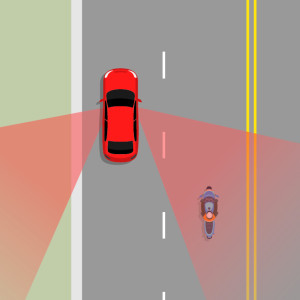Car drivers who collide with motorcycles often say they didn’t see the motorcycle. This is because the outline of a motorcycle and rider is much smaller than other vehicles, especially when seen from the front or back.
As a motorcycle rider, it’s safer to assume a driver hasn’t seen you.
Here are some things you can do to make yourself more visible to other road users.
Riding with your headlight on dip (low beam) during the day makes you and your motorcycle more noticeable.
If your motorcycle was manufactured on or after 1 January 1980, you must use your headlight on dip or daytime running lamps during daylight hours.
Brightly coloured, reflective helmets and clothing will help make you more visible. White, orange, yellow and red are the colours most easily seen. Reflective tape on your clothing or motorcycle can also help others to see you.
It’s a good idea to wear a reflective vest. A reflective vest is more noticeable to drivers behind you than a tail light is.
You should use the horn on your motorcycle to attract attention in a situation that could be dangerous. For example, if you and a vehicle in the lane next to you are both coming up behind a vehicle, the vehicle next to you may pull out to pass. Check the front wheels to see if they’re pulling out. Toot your horn in case the driver hasn’t noticed you.

Use your horn as a warning
You can use your position on the road to make sure others see you. For example, by riding at the correct following distance behind the right-hand wheels of the vehicle ahead, you’re more easily seen in their rear-vision mirrors and more likely to be noticed. This position also allows you to be seen by oncoming vehicles, and for you to see them.
You can also avoid oil slicks that form in the centre of lanes and discourage lane-sharing by other motorists.
There are some occasions when you’ll need to change your lane position because of changing traffic conditions. Here are some other ways you can ride your motorcycle where others can see you.

Ride where you can be seen.

Don't ride in driver's blind spots

Be seen at intersections

Be sure the driver of the turning vehicle has seen you
Accelerating fast or travelling over the speed limit may cause other road users to miss seeing you or misjudge your speed.
For example, a driver about to turn may see the way is clear but, before the turn is completed, a fast-moving motorcycle suddenly appears, changing the traffic situation. This can lead to a crash.